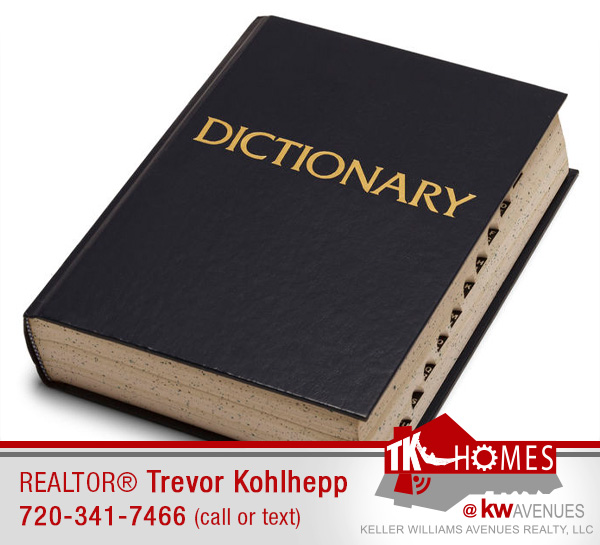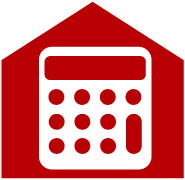BUYER'S RESOURCE »

Whether you have bought or sold a home in the Denver Metro area or not, if you are thinking about buying or selling a home there are some terms you should know. Some of these terms are new and unique to the current Denver Metro Real Estate Market and some are generic and will apply regardless of when you buy a home. Have you heard a term and are not sure what it means, and it’s not on this list? Share the term in the comments below and we’ll gladly define it for you!
1) CMA - (Comparative Market Analysis) - A realtor uses this tool to price a home competitively. They look at comparable homes within a close radius that are active on the market, are currently under contract or sold, usually within the last 3-6 months. There is an adjustment made based on the features of the home, such as square footage, the finishes, the number of bedrooms and bathrooms, etc. A CMA is very similar to an appraisal and is typically used to determine what a list price of a home should be.
2) Seller Net Sheet – This is the form that will showcase how much money a seller would get if they sold their home for a specific price. The Seller Net Sheet will include all of the expenses related to the sale of the home, including Title Fees, Commissions, Property Taxes, and any other expenses related to the home.
3) MLS - (Multiple Listing Service) - This is a database that real estate agents use that provides information on properties for sale. When a REALTOR® sets up a home search for a buyer, the homes that the buyer receives pictures of and information about that meet their criteria come from the MLS.
4) Single Property Website - One of the many marketing tools that homeowners selling their home with TK Homes will be able to take advantage of is a Single Property Website. This website has one sole purpose: to showcase your home. On the site it will display all the basic information, such as square footage, number of beds and baths, location, etc. Learn more about TK Homes’ Single Property Website.
5) Earnest Money - This is money deposited by the buyer to show that they are serious about purchasing a house they are under contract on. The Earnest Money is typically held by the title company or with the Listing Agent’s real estate company. The Earnest Money amount is 100% dependent on the transaction and is always negotiable. However, it is usually around 1% of the purchase price of the home.

6) Lead Based Paint - This is something that needs to be disclosed in any home that is built before 1978. There is a lead based paint test that a buyer can have completed during their inspection. A buyer will typically remedy a lead based paint situation by painting over the current paint in the home, but not always. If a property was built prior to 1978, it is required that a buyer receive a Lead Based Paint Disclosure from the seller. This lets the buyer know if the seller is aware of lead based paint in their home.
7) Seller Property Disclosure -This is the document that a seller fills out to disclose any known facts about the home. For example, if a seller has had previous water damage, they will need to disclose it in the Seller Property Disclosure. This document is then sent to the buyer, so they are aware of all information about the home.
8) Square Footage Disclosure - This is the document that a Seller fills out to disclose the square footage of the home. The form explains where the square footage number came from – it can be measured, come from the Assessor’s office or even from a previous appraisal. It also tells the date the measurement information was gathered. This document is required to be executed for every transaction by Colorado state law.
9) Escalation Clause - This is a clause that a buyer may add to their offer if there are multiple offers for a property that they are making an offer on, and they don’t know the amounts of the other offers. The clause says that they will go up in price in a specified amount until they are over the highest offer, and there is usually a cap of the amount they will go up to. Here is an example, if the asking price is $300,000, and there are multiple offers. One of the buyers decides to do an escalation clause, going up in increments of $1000 over the next highest offer until they get up to $320,000. This means that the maximum amount they are willing to go up to is $320,000.
10) Appraisal Gap - This is used when there are multiple offers and buyers are offering over asking price. Sellers get concerned when an offer is higher than asking price because they priced the home using a CMA and are concerned that the appraisal will not match the offered price. The appraisal gap is put into an offer by the buyer, and it varies depending on how much of the offer price a buyer wants to cover. Here is an example: if the list price of a home is $350,000, and a buyer offers $370,000, they may offer an appraisal gap to cover the extra $20,000 they offered over the asking price. In the event that the appraisal in this scenario came in at $360,000 the price would remain $370,000 and the buyer’s would make up the difference in the appraisal by bringing additional funds to the closing table. Learn more about Appraisals and Appraisal Gaps.
11) Waived Inspection - This is a tool a buyer uses to help get their offer accepted in a multiple offer situation. They may still do an inspection, but they are saying that they will not ask for any repairs to be done after inspection. Buyers still have the option to terminate if after inspection the costs of repairs is beyond what they are willing to take on.
12) Waived Appraisal - This means that there is no need for a traditional appraisal because either the buyer is paying with cash, or the buyer is using a certain loan program where the lender says an appraisal is not needed.
13) Escrow – Escrow is an account that is opened by a third party to store monies for future bills. The most common escrow accounts in a real estate transaction will be the one holding the Earnest Money and the one opened at time of Closing by the Buyer’s Lender. The money in these accounts are your funds, but they are held by a third party to pay future bills related to the property. The most common bills the escrow will pay is your annual property tax and home’s hazard insurance.
14) Pre-paids – Pre-paids are typically disclosed as part of a buyer’s closing costs. Pre-paids are going to be for services or taxes on the property that the Lender collects and puts into escrow for future bills. Examples of pre-paids are your home’s hazard insurance, annual property taxes and HOA dues.
15) Concessions - This is a dollar amount that a seller provides to the buyer to be used towards the Buyer’s Closing Costs, Pre-paids or other costs the Buyer’s Lender will allow. This amount will be on the Settlement Statement and comes directly out of the seller’s proceeds from the sale of the home.
16) Closing Costs – These are the costs associated with either purchasing or selling your home. For a seller, closing costs will include the real estate commission, title fees, recording fees and potentially concessions. For a buyer, the closing costs can be much higher if purchasing with financing as you will have some of the same fees with title, recording, etc. as the seller but also Closing fees associated with the loan and lender.
17) Contingency - This term is used when the buyer has a house to sell, and the purchase of their home is contingent on them selling their current home.
18) Closing Day- This is the day that sellers and buyers sign the papers in order to sell a home to a buyer. This is usually done at a Title Company. It is definitely a day to celebrate!
Although we tried to think of all the terms you might hear when buying or selling a home, it’s very possible we missed one or two. If you can think of a term not listed above, share it in the comments below, and we’ll be happy to define it for you!
~ Written by TK Homes REALTOR® Mary Smith









